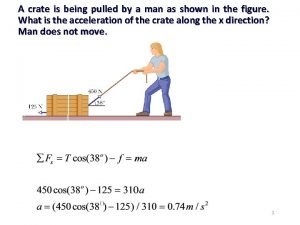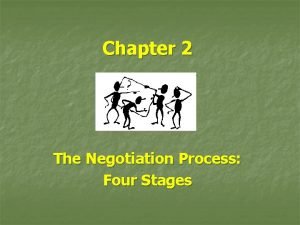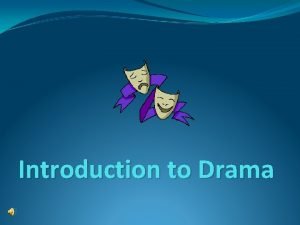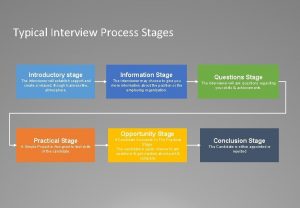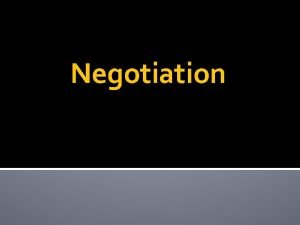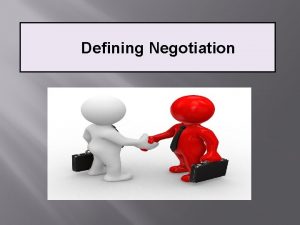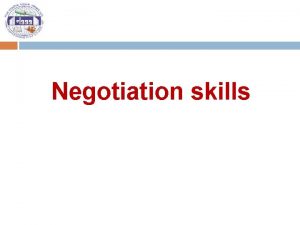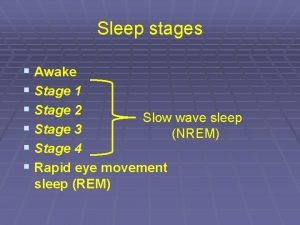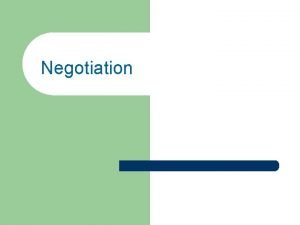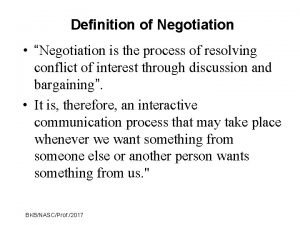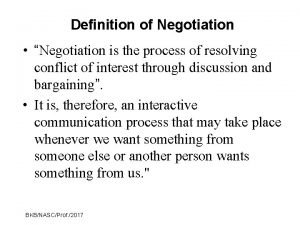NEGOTIATION PROCESS Stages of negotiation Stage 1 opponents












- Slides: 12

NEGOTIATION PROCESS • Stages of negotiation – Stage 1 --opponents get to know each other – Stage 2 --each side puts forward positions and arguments and learns about other side – Stage 3 --settlement zone – Stage 4 --conclusion

NEGOTIATION PROCESS (continued) • Strategy and tactics – Preparation • Management – Objectives – Monitoring worker attitudes – Scan of economic and political environment – Background research – Reviewing company policies – Examining grievances

NEGOTIATION PROCESS (continued) • Strategy and tactics (continued) – Preparation (continued) • Union – Objectives – Through knowledge of general and specific economic and political environment – Meeting needs of members – Process is more open

NEGOTIATION PROCESS (continued) • Strategy and tactics (continued) – Developing bottom line • Developed by each side • Developed before start of negotiations • Issues divided into categories – Issues over which party is prepared for strike – Trading issues – Give-up issues • Builds sense of team for negotiations

NEGOTIATION PROCESS (continued) • Strategy and tactics (continued) – Specific tactics • Opening position • Concessions and trade-offs • Threats and promises

NEGOTIATION PROCESS (continued) • Strategy and tactics (continued) – Desire to settle • Assumption that both parties want a conclusion and want agreement • Third-party intervention usually results in strike or lockout • Both sides need to “want” to settle for settlement to occur

CB SIMULATION • 1 page report – your team’s bargaining strategy – your opponent’s bargaining strategy – list of your objectives/changes (in order of importance) • not your opening position • due by 09: 30 am on May 26, 2014

CB Simulation • PREPARATION – read the case – discuss your options with your teammates – classify your issues • strike/lockout issues • trading issues • give up issues – develop your bottom line – work on different scenarios

CB Simulation • First 5 -10 minutes – awkward period • • try to get comfortable get to know each other feel the environment ice-breaking conversation • Put forward your positions and arguments – team meeting • do not agree to anything without a team meeting • try to develop an understanding of the other party’s bottom line • Start with minor issues

CB Simulation • INTEGRATIVE BARGAINING – Gain for one side is gain for the other side too – Deal with mutual problems • Tactics in integrative bargaining – Identifying the problem – searching for solutions – comparing alternatives

CB Simulation • DISTRIBUTIVE BARGAINING – Conflict over the allocation of a fixed amount of resources – Adversarial in nature • Tactics – Discovering the other side’s bottom line – Disguising your own side’s bottom line – Pressuring the other side to move its bottom line – Emphasizing your commitment to your position


